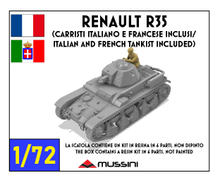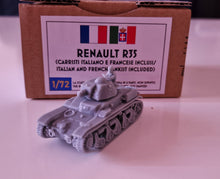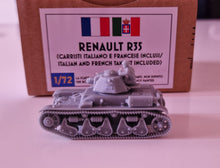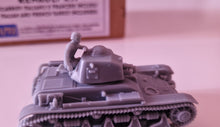
Il Renault R35 fu un carro armato leggero da accompagnamento per la fanteria progettato dalla Francia durante gli anni trenta e prodotto in oltre 1.600 esemplari, comprendendo anche le circa 100 unità della versione R40 con meccanica rivista. Il Renault R35 era armato con un cannone a canna corta Puteaux SA 18 da 37 mm ed era dotato di corazzature per l’epoca piuttosto spesse; tuttavia la concezione tattica che stava alla base della sua costruzione ne impedirono un proficuo utilizzo contro le più mobili Panzer-Division tedesche, che nel maggio e giugno 1940 fecero crollare la Francia.
A seguito dell'armistizio di Compiègne, centinaia di R35 furono riutilizzati dalla Germania come trattori d'artiglieria, veicoli portamunizioni o base semovente per cannoni anticarro e pezzi da campagna. Altri furono invece distribuiti ai paesi alleati, come l'Italia fascista, che ne ricevette circa 130, e la Bulgaria.
Dopo la distribuzione ai reparti il carro risultò adeguato, ma la sua carriera operativa rimase sempre inficiata dalla sua concezione base di mezzo adattato a scortare la fanteria, troppo lento per contrastare i veloci carri tedeschi; il cannone Puteaux 18 da 37 mm si dimostrò inoltre del tutto inefficace contro i blindati tedeschi, tanto che non rappresentò una seria minaccia neppure il carro armato leggero Panzer II, il più numeroso tra le forze corazzate tedesche che attaccarono l'Europa occidentale. Il 10 maggio 1940, giorno dell'inizio della campagna di Francia, i Renault R35 equipaggiavano ventuno battaglioni ognuno forte di quarantacinque veicoli. In totale erano in servizio sulla linea del fronte 945 carri tra R35 e R40.
Al momento dello sbarco in Sicilia nel luglio 1943, gli R35 vennero inquadrati nella divisione Livorno che li lanciò al contrattacco verso Gela. I carri di produzione francese, ormai obsoleti, vennero decimati durante la campagna di Sicilia, da cui sfuggì senza perdite il 131º Reggimento, che a metà agosto era rientrato nella penisola e il 1º settembre era stato inserito nell'organico della 136ª Divisione corazzata Centauro II, che però fu sciolta già l'8 settembre 1943, a causa dei convulsi eventi seguiti alla caduta del fascismo il 25 luglio. Sul continente si trovavano allora diciotto Renault R35: quattro vennero demoliti in prove di resistenza o per prelevarne organi meccanici, ma cosa sia accaduto ai superstiti quattordici non è noto.
Nelle confezioni Mussini si trova un modello di Renault R35 in scala 1/72 in 5 pezzi (torretta, scafo superiore, scafo inferiore e i due treni di rotolamento). E’ altresì inclusa una torretta con sportello aperto e due carristi, uno francese e uno italiano.
The Renault R35 was a light infantry support tank designed by France during the 1930s, with over 1,600 units produced, including about 100 units of the R40 version with revised mechanics. The Renault R35 was armed with a short-barreled 37 mm Puteaux SA 18 gun and featured relatively thick armor for its time; however, the tactical concept behind its design prevented it from being effectively used against the more mobile German Panzer Divisions, which overwhelmed France in May and June 1940.
After the Armistice of Compiègne, hundreds of R35s were repurposed by Germany as artillery tractors, ammunition carriers, or converted into self-propelled guns for anti-tank or field artillery. Others were distributed to allied countries, such as Fascist Italy, which received about 130 units, and Bulgaria.
After being distributed to various units, the tank proved to be adequate, but its operational career was always hindered by its basic design as an infantry support vehicle, too slow to counter the fast German tanks. Furthermore, the 37 mm Puteaux 18 gun proved entirely ineffective against German armored vehicles, to the point that it was not even a serious threat to the light Panzer II, the most numerous among the German armored forces that attacked Western Europe. On May 10, 1940, the day the French campaign began, Renault R35 tanks equipped twenty-one battalions, each with forty-five vehicles. A total of 945 R35 and R40 tanks were in service on the front lines.
At the time of the Allied landings in Sicily in July 1943, the R35s were part of the Livorno Division, which launched them in a counterattack towards Gela. These French-produced tanks, already obsolete, were decimated during the Sicilian campaign, although the 131st Regiment managed to escape without losses. By mid-August, the regiment had returned to the Italian peninsula and, on September 1, was incorporated into the 136th Centauro II Armored Division, which was dissolved on September 8, 1943, due to the turbulent events following the fall of Fascism on July 25. At that time, eighteen Renault R35s were still on the mainland: four were dismantled in durability tests or for parts, but the fate of the remaining fourteen is unknown.
In Mussini's kits, there is a 1/72 scale model of the Renault R35 in five pieces (turret, upper hull, lower hull, and two running gear assemblies). The kit also includes an open-hatch turret and two tank crew figures, one French and one Italian.









